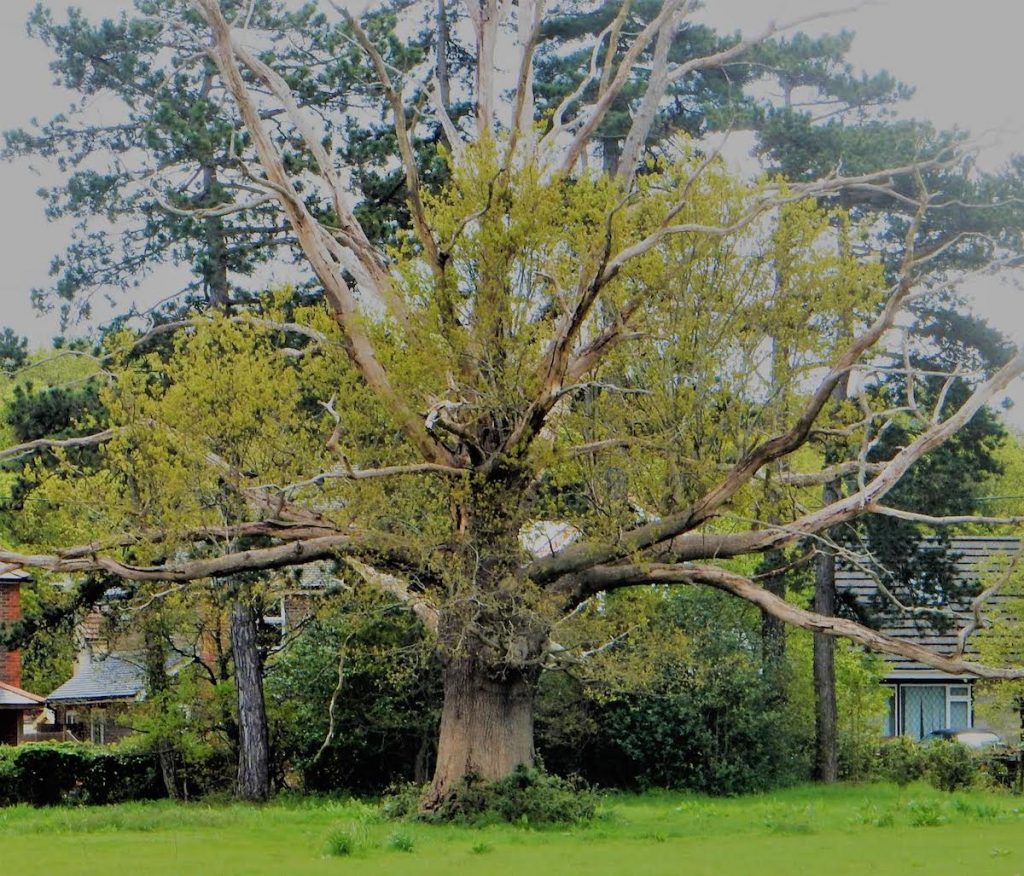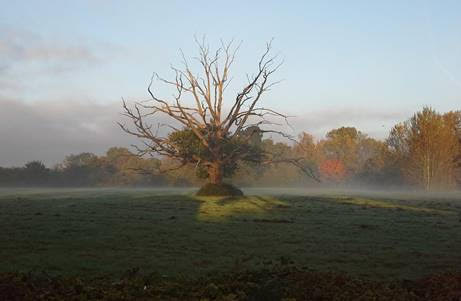 Abraham Lincoln
If given the truth, the people can be depended upon to meet any national crisis...
Abraham Lincoln
If given the truth, the people can be depended upon to meet any national crisis...
 Guildford news...
for Guildford people, brought to you by Guildford reporters - Guildford's own news service
Guildford news...
for Guildford people, brought to you by Guildford reporters - Guildford's own news service
Revised Interpretation of ‘Veteran’ Oak Tree Status Throws Ash Green Housing Scheme Into Confusion
Published on: 22 Jun, 2021
Updated on: 24 Jun, 2021
By David Reading
Two applications to build homes near the site of the historic Ash Manor House in Ash Green were removed from Guildford Borough Council’s Planning Committee agenda, June 16, at the last minute.
The reason is that council officers had received additional information from their tree officer relating to the status of an old oak tree (known as T67) and its possible categorisation as a veteran tree. This new information classing it as a veteran offers it protection – and could send the plans for the 73 homes back to the drawing board.
A leading campaigner, Sue Wyeth-Price, is delighted that the deferment gives the residents respite, but she is furious because of the timing of the new developments. She believes that the additional information relating to the oak has existed for some time – an assertion strongly denied by the council.
It was Ms Wyeth-Price who secured a Judicial Review into the council’s 2019 decision to approve the 73 homes. Presenting the findings of the review in December 2020 a High Court judge overruled the council’s approval because a planning officer’s report “seriously and materially” misled the planning committee.
Ms Wyeth-Price now believes her “costly and time-consuming” efforts in securing the review were unnecessary. She believes that had the tree officer noted this information in a more timely manner, and bought it to the councillors’ attention at the outset, they might never have approved the scheme.
Ms Wyeth-Price, a leading member of Ash Green Residents Association (AGRA), said relevant information about the oak was available for between one and three years, before the Judicial Review hearing. “We have wasted a great deal of time, effort and money, and been forced to pay for our own consultants on this when all the time the information was available to the tree officer. It also shows that our documents were completely ignored.”
However, Guildford Borough Council strongly contests Ms Wyeth-Price’s view of the events. Although it is a fact that the council’s tree officer, Mr Tim Holman, reviewed and changed his original assessment – and now believes the tree should be protected – the council said he reached that earlier conclusion in good faith based on information available at the time.
Cllr Tom Hunt, the council’s lead member for development management, said: “The assertion that the council knew about the additional information found by Mr Holman for some time is incorrect and has the effect of making it appear that the council is lacking openness and transparency. The council has been open and transparent all along.
“Determining whether a tree is veteran or not is not a simple calculation. It is a subjective assessment requiring the exercise of judgment. Mr Holman made an assessment based on the information available to him at the time, and an interpretation of the data that he believed was valid.
“The week before last, having reviewed his analysis, and having identified two new pieces of information, he re-evaluated his assessment based on this new information. One of the documents supporting his revised assessment is dated June 2020, so it could not possibly have been available at the outset of this application.”
An email sent by Mr Holman to John Busher, a principal GBC planner, explains Mr Holman’s amended point of view.
The email said: “My revised interpretation is that T67, with a four-metre girth, is now within the classification band for a veteran tree. I can confirm that because of its age, and now size, and because it already has sufficient veteran features, that in accordance with the NPPF the oak tree T67 does in fact qualify as a veteran tree and should be protected accordingly.”
Mr Holman said the reason for his original decision – that the tree should not be classed as veteran – was based on size and interpretation of a girth chart found in the publication “Ancient and other veteran trees: further guidance on management.” But he said further investigation led him to a different conclusion.
Ms Wyeth-Price claims that all of the information on which the revised decision was made had been presented to the officer by AGRA in comments and objections going back to February 2019
Explaining the planning committee’s decision to remove Bewley Homes’ two applications from the agenda, Cllr Hunt said: “We withdrew both Ash Manor applications (18/P/02456 and 20/P/01461) from our Planning Committee agenda on Wednesday 16 June after receiving a further assessment from our Tree Officer about the status of one of the trees on the land covered by the applications. We will now consider the new information and assess it against local and national policy.
“An appeal has been placed against the 20/P/01461 planning application for no decision being made within the 13-week determination period. The Planning Inspectorate timetable has been published on our website. Application 18/P/02456 has not yet been appealed, and will be determined in accordance with our adopted procedures.”
The two applications effectively amount to the same thing – Bewley Homes’ intention to build 73 homes on the site. One of these has gone to appeal because no decision had been made within the 13-week period. The council says the other will be determined “in accordance with our adopted procedures.” The tree officer’s latest findings are now being evaluated.
Responses to Revised Interpretation of ‘Veteran’ Oak Tree Status Throws Ash Green Housing Scheme Into Confusion
Leave a Comment Cancel replyPlease see our comments policy. All comments are moderated and may take time to appear.
Recent Articles
- Guildford Institute’s Crowdfunding Project for Accessible Toilet in its New Community and Wellbeing Centre
- Letter: Guildford – Another Opportunity Missed?
- Letter: GBC’s Corporate Strategy – Where Is the Ambition?
- My Memories of John Mayall at a Ground-breaking Gig in Guildford Nearly Six Decades Ago
- Westborough HMO Plans ‘Losing the Heart of the Street’ Says Resident
- College Invests to Boost Surrey’s Economy and Close Digital Skills Gap
- Community Lottery Brings Big Wins for Local Charities
- GBC Housing Plan Promises ‘A Vibrant Urban Neighbourhood’ Near Town Centre
- Hospital Pillows ‘Shortage’ at the Royal Surrey
- Updated: Caravans Set Up Camp at Ash Manor School


Recent Comments
- Ian Macpherson on Updated: Main Guildford to Godalming Road Closed Until August 1
- Sara Tokunaga on GBC Housing Plan Promises ‘A Vibrant Urban Neighbourhood’ Near Town Centre
- Michael Courtnage on Daily Mail Online Reports Guildford Has Highest-paid Council Officer
- Alan Judge on GBC Housing Plan Promises ‘A Vibrant Urban Neighbourhood’ Near Town Centre
- John Perkins on GBC Housing Plan Promises ‘A Vibrant Urban Neighbourhood’ Near Town Centre
- S Collins on GBC Housing Plan Promises ‘A Vibrant Urban Neighbourhood’ Near Town Centre
Search in Site
Media Gallery
Dragon Interview: Local Artist Leaves Her Mark At One of England’s Most Historic Buildings
January 21, 2023 / No Comment / Read MoreDragon Interview: Lib Dem Planning Chair: ‘Current Policy Doesn’t Work for Local People’
January 19, 2023 / No Comment / Read MoreA3 Tunnel in Guildford ‘Necessary’ for New Homes, Says Guildford’s MP
January 10, 2023 / No Comment / Read More‘Madness’ for London Road Scheme to Go Ahead Against ‘Huge Opposition’, Says SCC Leader
January 6, 2023 / No Comment / Read MoreCouncillor’s Son Starts Campaign for More Consultation on North Street Plan
December 30, 2022 / No Comment / Read MoreCounty Council Climbs Down Over London Road Works – Further ‘Engagement’ Period Announced
December 14, 2022 / No Comment / Read MoreDragon Interview: GBC Reaction to the Government’s Expected Decision to Relax Housing Targets
December 7, 2022 / No Comment / Read MoreHow Can Our Town Centre Businesses Recover? Watch the Shop Front Debate
May 18, 2020 / No Comment / Read More













Jim Allen
June 22, 2021 at 5:38 pm
I’m not sure why there is any confusion. If it’s an oak with a girth greater than 3.2 metres it becomes “of interest” at 4.7 metres girth, it is considered “valuable” in conservation terms, at 6.25 metres it is truly ancient.
A simple tape measure and a site visit could have ascertained this.
And even if the tree is anything less, then you should not cut it down because it’s got a long way to grow. Why destroy a living tree that helps ecology requirement in the National Planning Policy Framework.
Gill Squibb
June 23, 2021 at 1:42 pm
This application is the very same one that was quashed at the Judicial Review. Sue Wyeth-Price took this on, on behalf of Ash Green Resident’s Association (AGRA), in early 2020 following the December 2019 decision to approve.
One of the four original grounds was: “Failure to have regard to a relevant consideration, namely, the advice of Surrey Wildlife Trust in respect of a veteran tree at the site and acting irrationally in departing from the advice without reasons.”
GBC won this single argument. One was conceded on the basis of expert qualifications, one was withdrawn beforehand, and we won the heritage argument. So, the only ground GBC won is the very one they now say they got wrong. This raises many questions.
How many other times have valuable, veteran or otherwise, trees or hedgerows been destroyed needlessly because available information has been ignored?
Why has GBC now employed Thomson Ecology, who produced the AGRA tree report they so disparaged in the latest officer report, as their new tree consultants?
The JR cost AGRA a considerable amount of time, effort and money and would have been completely unnecessary if the Tree Officer had made the correct assessment of the tree’s value in the first place. How many other times have the decisions been wrong but because the cost of rectifying it is placed on the residents, allowed to go through because of financial or time constraints?
How much has this application cost GBC? Their costs for just responding to the pre-application protocol letter were almost £3,000. The barrister costs for their day in court and the preparation would have been much, much more. And then there is the number of times they have used a barrister to assess the documents, comments and objections, brief the councillors and attend the planning committee meetings, all related to this one application.
So now we have been proved right on the heritage and the tree, that only leaves the drainage/groundwater, I suppose we should take comfort from the words of the song “two out of three ain’t bad”!
Gill Squibb is the chair of Ash Green Resident’s Association